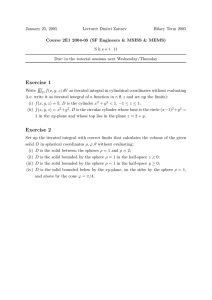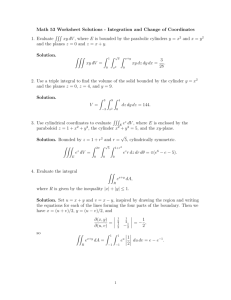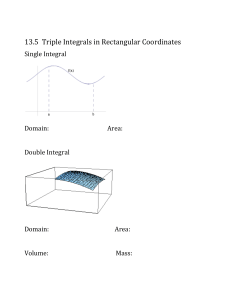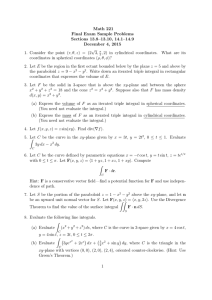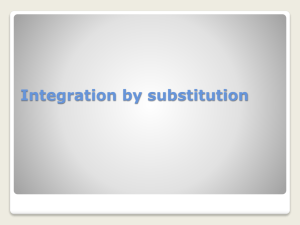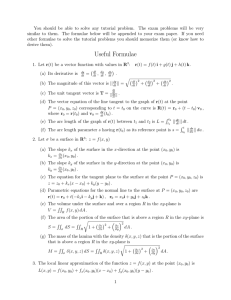MATH 221.504 Exam 2 Solutions November 16, 2015 1.
advertisement
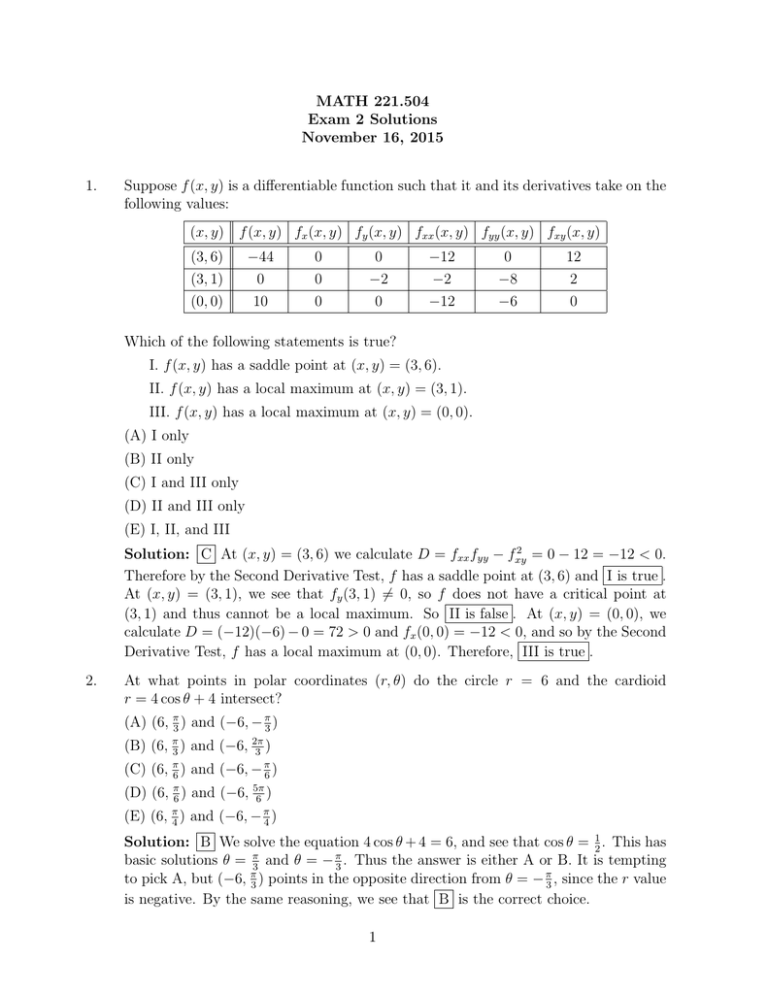
MATH 221.504
Exam 2 Solutions
November 16, 2015
1.
Suppose f (x, y) is a differentiable function such that it and its derivatives take on the
following values:
(x, y) f (x, y) fx (x, y) fy (x, y) fxx (x, y) fyy (x, y) fxy (x, y)
(3, 6)
(3, 1)
(0, 0)
−44
0
10
0
0
0
0
−2
0
−12
−2
−12
0
−8
−6
12
2
0
Which of the following statements is true?
I. f (x, y) has a saddle point at (x, y) = (3, 6).
II. f (x, y) has a local maximum at (x, y) = (3, 1).
III. f (x, y) has a local maximum at (x, y) = (0, 0).
(A) I only
(B) II only
(C) I and III only
(D) II and III only
(E) I, II, and III
2
= 0 − 12 = −12 < 0.
Solution: C At (x, y) = (3, 6) we calculate D = fxx fyy − fxy
Therefore by the Second Derivative Test, f has a saddle point at (3, 6) and I is true .
At (x, y) = (3, 1), we see that fy (3, 1) 6= 0, so f does not have a critical point at
(3, 1) and thus cannot be a local maximum. So II is false . At (x, y) = (0, 0), we
calculate D = (−12)(−6) − 0 = 72 > 0 and fx (0, 0) = −12 < 0, and so by the Second
Derivative Test, f has a local maximum at (0, 0). Therefore, III is true .
2.
At what points in polar coordinates (r, θ) do the circle r = 6 and the cardioid
r = 4 cos θ + 4 intersect?
(A) (6, π3 ) and (−6, − π3 )
(B) (6, π3 ) and (−6, 2π
)
3
(C) (6, π6 ) and (−6, − π6 )
(D) (6, π6 ) and (−6, 5π
)
6
(E) (6, π4 ) and (−6, − π4 )
Solution: B We solve the equation 4 cos θ + 4 = 6, and see that cos θ = 12 . This has
basic solutions θ = π3 and θ = − π3 . Thus the answer is either A or B. It is tempting
to pick A, but (−6, π3 ) points in the opposite direction from θ = − π3 , since the r value
is negative. By the same reasoning, we see that B is the correct choice.
1
3.
Suppose Q is the rectangle in the xy-plane bounded by the lines x = 0, x = 2, y = 0,
and y = 3, and suppose that Q has a mass density given by
δ(x, y) = xy 2 .
If the total mass of Q is M , which of the following integrals represents the y-coordinate
of the center of mass of Q?
Z 2Z 3
1
(A)
x2 y 2 dx dy
M 0 0
Z 2Z 3
1
xy 3 dx dy
(B)
M 0 0
Z 3Z 2
1
(C)
xy 3 dx dy
M 0 0
Z 2Z 3
1
(D)
x2 y 2 dy dx
M 0 0
Z 3Z 2
1
xy dy dx
(E)
M 0 0
Solution: C The formula for the y-coordinate of the center of mass is
ZZ
1
y=
yδ(x, y) dA,
M
R
4.
where R is the rectangle described in the problem. Thus the correct answer is either
B of C. Checking the limits of integration, together with the orders of integration
given, we see that C is the answer.
√
Let R be the region in the xy-plane bounded by theZgraphs
of y = 2x and y = 8x.
Z
f (x, y) dA?
Which of the following iterated integrals represents
4
Z
√
Z
R
8x
(A)
f (x, y) dy dx
0
Z
2x
2 Z 2x
(B)
4
Z
8x
2x
Z
(C)
√
0
Z
f (x, y) dy dx
√
0
2
Z
f (x, y) dx dy
8x
8y 2
(D)
f (x, y) dx dy
0
Z
y/2
4
Z
y/2
(E)
f (x, y) dx dy
0
y 2 /8
Solution:
E First we find the points of intersection of the two curves, and setting
√
2x = 8x, we see that 4x2 = 8x, and thus
4x2 − 8x = 4x(x − 2) = 0.
2
5.
The line and the curve intersect at (0, 0) and (2, 4). The region R is thus bounded
on the left by a parabola pointing to the right and on the right by a line. Solving for
x we see that the parabola is x = y 2 /8 and the line is x = y/2, which leads to the
solution in E.
Z 2 Z 4−x2
f (x, y) dy dx, we obtain
If we change the order of integration of the integral
0
which integral below?
Z 2 Z √y−4
(A)
f (x, y) dx dy
0
2
4
Z
Z
0
√
4−y
(B)
f (x, y) dx dy
0
0
2
Z
4
Z
(C)
f (x, y) dx dy
4−y 2
0
Z
(D)
0
4
Z
4
√
4− y
f (x, y) dx dy
(E) None of the above
Solution: B We first need to identify the region of integration, which is defined by
the inequalties
R = {(x, y) | 0 ≤ x ≤ 2, 0 ≤ y ≤ 4 − x2 }.
Thus R is the region in the first quadrant bounded by a parabola facing downward
with vertex at (0, 4) and the coordinate axes. Switching the order of the inequalities,
we start
√ with 0 ≤ y ≤ 4, and solving for x in the equation of the parabola, we have
x = 4 − y. For fixed y,√we are taking x-values extending from the y-axis to the
parabola, and so 0 ≤ x ≤ 4 − y. Thus the answer is B.
6.
Let S be the surface defined by the graph of the paraboloid z = x2 + y 2 lying above
the triangle in the xy-plane with vertices (0, 1), (0, 7), and (2, 7). Write down an
iterated double integral that expresses the surface area of S. You do not need to
evaluate the integral.
Solution: The triangle in question is bounded on the left by the y-axis, on the top
by the line y = 7, and on the right/bottom by the line y = 3x + 1. Therefore, the
triangle is defined by the inequalities 0 ≤ x ≤ 2 and 3x + 1 ≤ y ≤ 7. Now for the
surface area of S, we have
s 2
Z 2Z 7 p
ZZ
2
∂z
∂z
+
+ 1 dA =
S.A. =
4x2 + 4y 2 + 1 dy dx .
∂x
∂y
0
3x+1
R
Equally good is to have changed the order of the variables and found
Z
7
Z
(y−1)/3
p
4x2 + 4y 2 + 1 dx dy .
S.A. =
1
0
3
7.
Let f (x, y) = 4x2 − 4xy + y 2 . What are the maximum and minimum values of f (x, y)
on the circle x2 + y 2 = 20? At what points (x, y) do they occur? You must use the
method of Lagrange multipliers.
Solution: Let g(x, y) = x2 + y 2 − 20. By the method of Lagrange multipliers we
want to solve the system of equations,
g = 0,
fx = λgx ,
fy = λgy .
We then have the three equations
x2 + y 2 = 20
8x − 4y = 2λx
−4x + 2y = 2λy.
(1)
(2)
(3)
If we multiply (3) by 2, we obtain −8x + 4y = 4λy, and if we add this to (2), we
obtain
0 = 2λx + 4λy = 2λ(x + 2y).
Thus either λ = 0 or x = −2y. If λ = 0 , then equation (2) reduces to 8x − 4y = 0
or y = 2x. Substituting this into (1), we find that 5x2 = 20, and so x = ±2. Since
y = 2x, we find two solutions:
(x, y) = (2, 4),
(x, y) = (−2, −4).
Now if x = −2y , then we substitute into (1) and find 5y 2 = 20. Thus y = ±2, and
using x = −2y, we find two more solutions:
(x, y) = (−4, 2),
(x, y) = (4, −2).
To find the maximum and minimum values, we evaluate f at these four points:
f (2, 4) = 0
f (−2, −4) = 0
f (−4, 2) = 100
f (4, −2) = 100.
Thus the maximum value is 100 , occurring at (x, y) = (−4, 2) or (4, −2) . Furthermore, the minimum value is 0 , occurring at (x, y) = (2, 4) or (−2, −4) .
8.
Let E be the solid in 3-space which is bounded above by the surface z =
(the top half of an ellipsoid) and below by the plane z = 3.
p
27 − 2x2 − 2y 2
(a) Express the volume of E as an iterated double integral in rectangular coordinates.
(You do not need to evaluate the integral.)
(b) Convert the integral from part (a) into an iterated double integral in polar
coordinates.
4
(c) Evaluate the integral from part (b) to find the volume of E.
Solution: We first need to identify the region R in the xy-plan sitting below E. We
know that E is bounded above by a paraboloid and below by a plane, so the boundary
of R will be the projection of the intersection of the two surfaces onto the xy-plane.
The intersection is obtained by solving
p
3 = 27 − 2x2 − 2y 2 ,
which becomes 9 = 27 − 2x2 − 2y 2 . This simplifies to x2 + y 2 = 9, and thus R is the
circle of radius 3 centered at the origin.
(a) For the volume in rectangular coordinates, we have
Z
p
2
2
27 − 2x − 2y − 3 dA =
ZZ
V =
3
−3
R
√
Z
9−x2
p
27 − 2x2 − 2y 2 − 3 dy dx .
√
− 9−x2
(b) In polar coordinates, we have
Z
p
2
2
27 − 2x − 2y − 3 dA =
ZZ
V =
0
R
2π
Z
3
√
27 − 2r2 − 3 r dr dθ .
0
(c) To evaluate the integral in (b) we find
Z 3 √
Z 3
2
r 27 − 2r dr − 2π
V = 2π
3r dr
0
0
Z
3
2π 9 √
=−
u du − 2π 23 r2 0 ,
(using u = 27 − 2r2 , du = −4r dr)
4 27
π 2 3/2 27
27
u
=
− 2π ·
3
9
2
2
π √
= 81 3 − 27 − 27π
3
√
= 27 3 − 36 π .
9.
[14 points; (a) 6 pts., (b) 8 pts.] Consider the integral
Z 4Z 2
(x2 + 1)1/3 dx dy.
0
y/2
(a) Describe the region of integration in the xy-plane for the integral above. Either
describe in words, or draw a labeled sketch of the region.
(b) Evaluate the integral.
Solution: (a) The region is the triangle bounded by the lines y = 2x, y = 0, and
x = 2. Its vertices are (0, 0), (2, 0), and (2, 4). Various answers were appropriate.
5
(b) In order to perform the integration it is necessary to reverse the order of the
variables. We see that
Z 2 Z 2x
Z 4Z 2
2
1/3
(x2 + 1)1/3 dy dx
(x + 1) dx dy =
0
0
0
y/2
Z
2
=
2x(x2 + 1)1/3 dx
Z0 5
u1/3 du
(using u = x2 + 1, du = 2x dx)
1
5
3 4/3
= u
4
1
3 3/4 3
= ·5 −
4
4
3 4/3
5 −1 .
=
4
=
6
